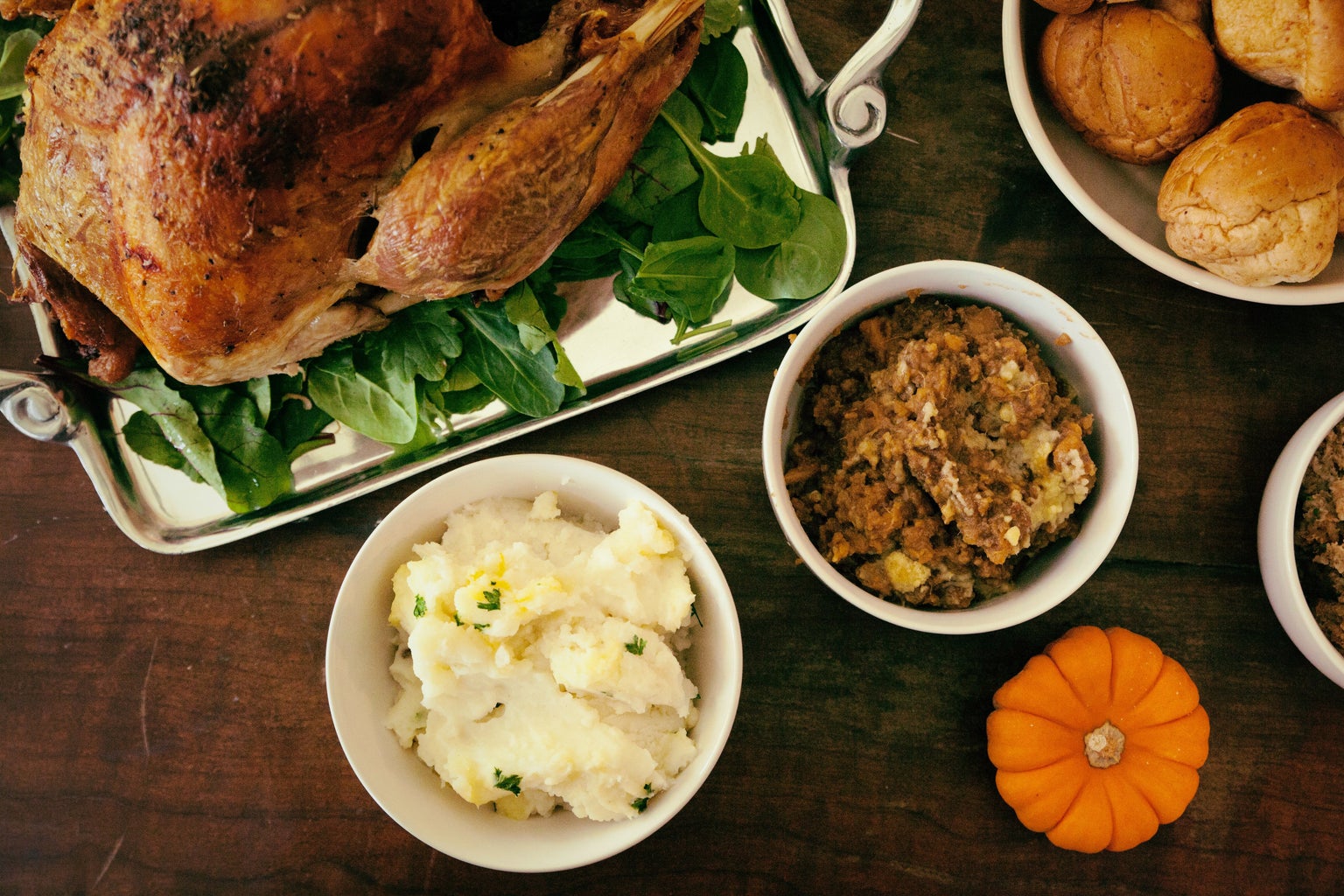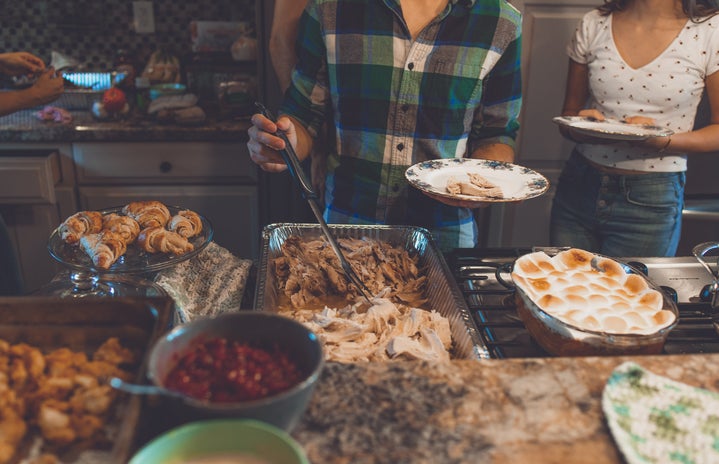Nothing says home, family, and fall quite like Thanksgiving. Characterized by gleeful children watching the Macy’s Parade, excited screaming at the football games on TV, crazed shopping, and eating until your pants explode, the fourth Thursday of November is one thing that can be called truly American.
Unfortunately, Thanksgiving 2020 is going to look very different than the family-gathering holiday to which we’re accustomed. In such a time of political and social uncertainty and unrest, 399 years after the very first Thanksgiving, it is important, and more timely than ever, to recognize the true origins of the celebration: settlers and natives, people of seemingly different worlds, coming together to celebrate despite the year’s uneasiness and hardships. Here is a brief history to reflect upon as we stuff ourselves full of stuffing this Thursday:
The First Thanksgiving
When asked to picture the very first Thanksgiving, most people probably imagine Pilgrims with buckled hats and Native Americans with feathered headdresses feasting at long tables. You know, what they taught us back in Kindergarten.
However, not much is actually known about the first Thanksgiving. Only two primary sources documenting the event exist. The first is a paragraph written by Edward Winslow published a year after the feast in a pamphlet called Mourt’s Relation. In this, the Pilgrim described how the Governor sent men to hunt fowl for a “special…rejoice,” and the arrival of King Massasoit of the Wampanoag with “some ninetie men” and five killed deer. According to Winslow, they celebrated and feasted for three days. This united rejoice for the year’s harvest has been pinpointed as the origin of Thanksgiving.
The second discovered primary source is a passage written by the Plymouth Colony Governor at the time, William Bradford, in his history of the colony titled Of Plymouth Plantation. Although published a couple of decades after the celebration, the passage provides another detailed glance into what occurred that celebratory autumn. In it, Bradford describes the happiness of being “well recovered in health & strength” after the tumultuous and deadly first year of living in the New World. He explains that there was no want as the plentiful harvest of cod, bass, fowl, turkey, venison, and corn was shared amongst families and communities. There was so much food, some Pilgrims wrote home about how much they had to eat. This, to the colonists, was truly something to celebrate.
These two short documents present everything we know about the inaugural Thanksgiving. Everything else we associate with the celebration was assumed by historians based on what a typical colonial feast would have looked like and what food sources were documented in additional primary sources from around the same time. Some of these assumptions include that the feast attendees dined on pumpkin, lobster, grapes, and cranberries. Although not explicitly documented, historians note that these foods were bountiful in the harvest that year, and may have very well been on the dinner table.
Overall, the first Thanksgiving represents a mix of English, Puritan, and Native traditions as those of different cultures gathered in peace to celebrate and give thanks. However, this day of thankfulness had a long road ahead before it became a well-known national holiday.
The first national Thanksgiving was declared by the Continental Congress in 1777. After that, Presidents Washington, Adams, and Monroe proclaimed national Thanksgivings on the last Thursday of November. This tradition, however, fell out of practice by 1815, as declaring observance of the holiday fell to individual states rather than the chief executive.
In 1827, influential editor Sarah Josepha Hale started a campaign to reinstate Thanksgiving as a national holiday, and she succeeded by convincing President Lincoln in 1863 that a proclamation would unite the warring nation. That year, there were two Thanksgivings. In 1941, Congress finally established Thanksgiving as a national holiday on the last Thursday of November.

The Thanksgiving of Today
Today’s Thanksgiving celebrations have come a long way since the Pilgrims and Wampanoags first originated the idea. However, when thinking of both the original and modern version of the holiday, one tradition stands out: plentiful supplies of food.
The yearly harvest is a celebratory event that has withstood centuries of regional and cultural changes in the United States. While standards like turkey have survived from the original feast, the Thanksgiving meal has changed significantly since 1621. The traditional Thanksgiving dinner of today features a turkey, stuffing, mashed potatoes, gravy, cornbread, rolls, and a desert of pumpkin pie. The original feasters, unfortunately, did not have access to the last delicious treat. This spread is especially true of Northeast families, for the meal is based on the New England fall harvest. Over the years, regional differences have impacted the traditional Thanksgiving meal as dishes evolved to reflect each region’s own harvest. For example, Thanksgiving dinners in the Southwest may include chiles and other locally harvested spices. In the Chesapeake Bay area, crab often makes an appearance, and in Baltimore, it is even common to serve sauerkraut with the turkey. As the nation has grown, so has the variety of food traditions during this gluttonous holiday.
Another famous Thanksgiving tradition is the Macy’s Thanksgiving Day Parade. On this morning, it is common to find families crowded in front of the TV, watching the gigantic balloons float down 34th Street. The Rockettes dazzle with their high kicks; celebrity singers blow us away with their amazing vocals; and the holiday cheer starts to sink in as Santa concludes the world’s largest parade.
Some other Thanksgiving favorites include watching the day’s three NFL games and prepping for Black Friday’s shopping craze. After all, if you’re going to be out shopping until 2 a.m, you’d better have some preparation.
2020 is a time like no other, and 400 years after the Pilgrims first landed in Massachusetts, we are looking at history through a different lens. It hasn’t been until the last century or so that Native Americans were recognized to share that first Thanksgiving meal with the colonists. As we gain a greater understanding of our society, it is important to remember the incredibly profound impact that Native Americans had on the foundation of the modern United States, and the injustices, illnesses, and atrocities that the intruding colonists imposed on these people that resulted in nothing less than a genocide. While still largely ignored by the American population, some progress has been made in recent years. Recently, the football team formerly known as the Washington Redskins changed their name to the Washington Football Team, permanently getting rid of the offensive mascot. Closer to the original Pilgrims, Plimoth Plantation changed its name this year to Plimoth Patuxet in honor of the Wampanoag name for the region and to remind us that native people were a major part of the success of that settlement. As you gobble down your turkey this Thursday, take a moment to reflect on the impact indigenous communities have had on our nation and the injustices they are still facing in society today.
Tips for Having a Safe COVID-19 Thanksgiving
As the COVID-19 pandemic continues through the fall of 2020, it is important to continue to follow governmental suggestions and social distancing protocols. Unfortunately, this Thanksgiving is going to have to be very different than normal. The CDC published an article with tips on safely celebrating Thanksgiving with your families this year, and the New York Times published some great ideas for celebrating at home. Here are some more things you can do with your family this turkey season:
The 94th Macy’s Thanksgiving Day Parade is still happening! The route has been reduced in size with no live spectators. This year, everyone will be tuning in on TV. Balloons will still fly and floats will still float. Pre-recorded Broadway performances will be shown, and country superstar Dolly Parton will be gracing the screen with her presence. Tune in to NBC at 9 a.m. EST to watch!
Looking for a family activity to keep everyone entertained? Start decorating for the holiday season, learn how to cook something new, or try a scavenger hunt!
Most of all, please stay healthy and safe. Have a very wonderful Thanksgiving full of gratitude, giving, and cheer. Happy eating!




